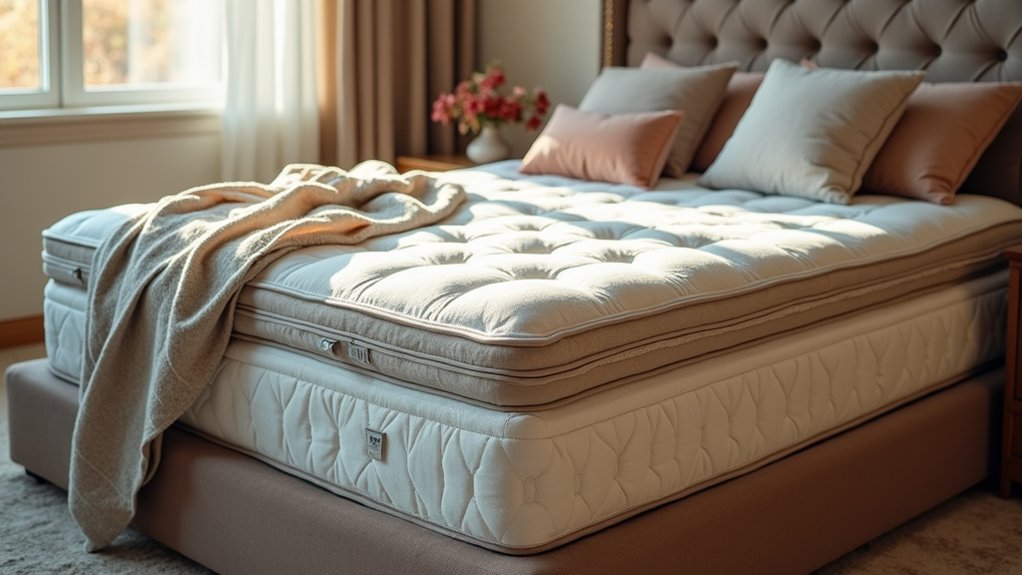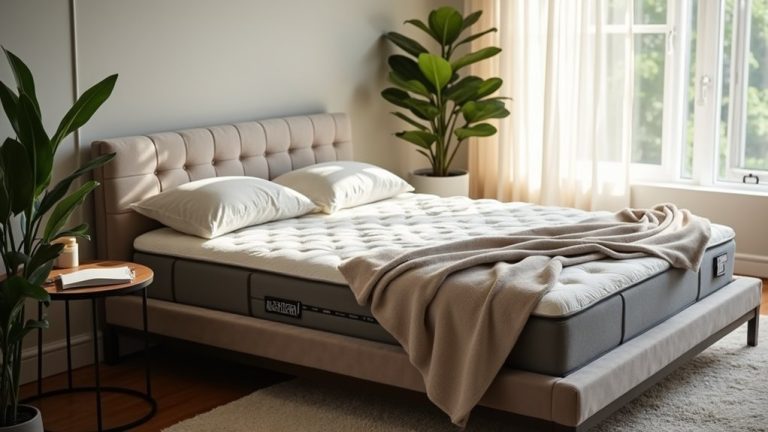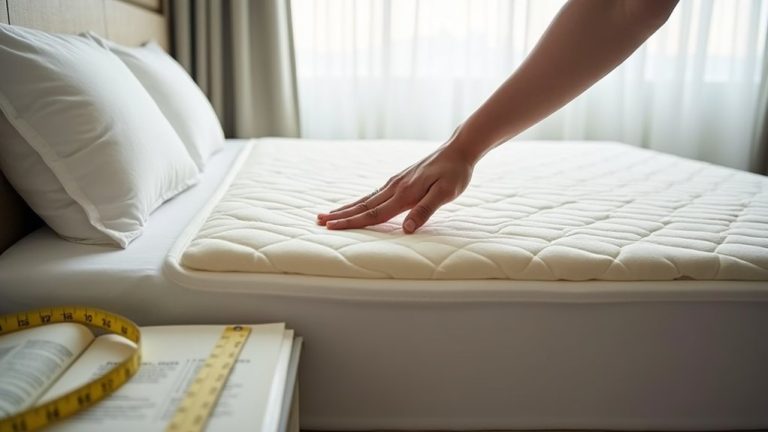The Ultimate Buying Guide for Innerspring Mattresses
When you're in the market for an innerspring mattress, it's crucial to navigate the various options available to secure you make the best choice for your sleep needs. You'll want to evaluate factors like coil types, material quality, and support features that align with your preferences. Understanding how each element impacts comfort and durability can greatly influence your decision. So, what should you prioritize to assure a restful night's sleep? Let's explore the key components that can make or break your mattress experience.
Understanding Innerspring Mattresses

When it comes to choosing a mattress, understanding innerspring mattresses is essential for making an informed decision. These mattresses utilize a coil support system, which greatly impacts comfort and durability.
#
Types of Innerspring Coils
- Bonnell Coils: Hourglass-shaped and interconnected, providing basic support; common in entry-level models.
- Offset Coils: Feature squared tops and bottoms for better body contouring than Bonnell coils.
- Continuous Coils: Made from a single wire; they're stiff and cost-effective but may lack flexibility.
- Pocketed Coils: Individually wrapped, offering superior contouring and reduced motion transfer for undisturbed sleep.
- Microcoils: Smaller coils, often found in hybrid mattresses, providing additional support and pressure relief.
Performance Characteristics
- Support: Bonnell coils offer firm support; Offset and Pocketed coils excel in contouring.
- Durability: Offset coils generally outlast Bonnell coils.
- Motion Transfer: Bonnell coils may disturb sleep partners, while Pocketed coils minimize this issue. Additionally, coil design advancements have led to improved support and comfort over the years.
Understanding these features helps you select the right innerspring mattress tailored to your comfort and support needs.
Material Quality Considerations
Material quality plays an essential role in the performance and longevity of innerspring mattresses. When evaluating coil materials, focus on the following aspects:
Coil Durability
- High-Quality Steel: Coils made from high-quality steel enhance durability.
- Tempering Process: Coils are often tempered using heat or electricity, improving their ability to return to their original shape.
- Corrosion Resistance: Look for rust-proof treatments or coatings to prevent wear over time.
Comfort Layers and Upholstery
- Layer Composition: Comfort layers typically feature materials like memory foam or latex. Upholstery often includes cotton batting and urethane foam.
- Softness and Support: More upholstery generally means better comfort, preventing direct contact with coils. Additionally, the use of high coil count can provide enhanced support and improve overall sleep quality.
Insulation and Mattress Cover
- Insulation Materials: Insulation prevents top materials from penetrating the coils, enhancing durability. Common options include synthetic fibers and rubberized curled hair.
- Cover Quality: A good cover, typically cotton or polyester blend, offers stain resistance and flame-retardant finishes.
Foundation Support
– Foundation Quality: A sturdy foundation contributes one-third of the total mattress support. Verify it's compatible to maintain warranty validity.
## Types of Innerspring Coils
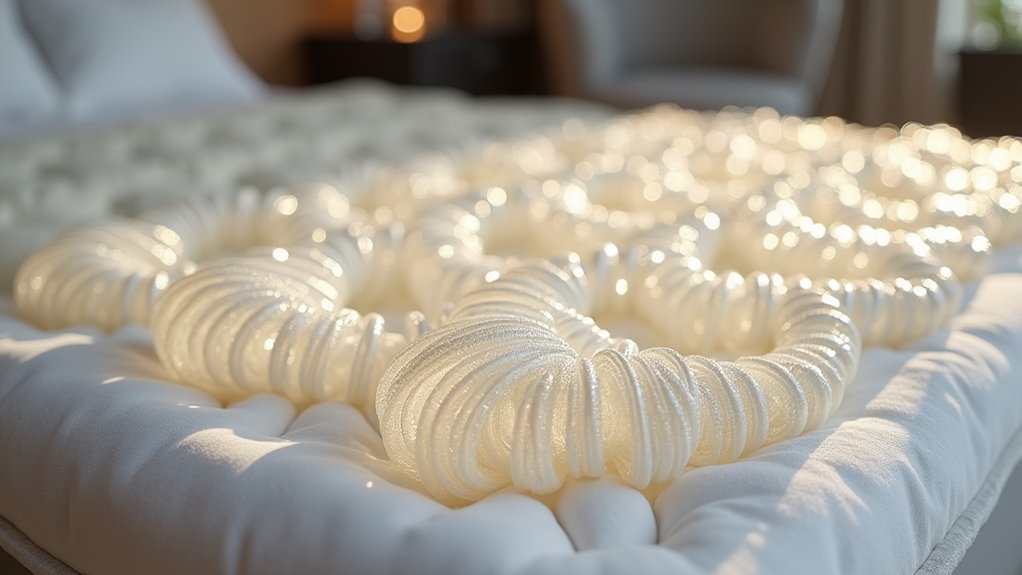
Understanding the different types of innerspring coils is key to selecting the right mattress for your needs. Here's a breakdown of the main types:
Bonnell Coils
- Description: Hourglass-shaped, interconnected by metal wires.
- Uses: Commonly found in entry-level mattresses due to cost-effectiveness.
- Support: Provides firm support but lacks conformity to body contours.
- Durability: Moderate lifespan; prone to motion transfer.
Offset Coils
- Description: Similar to Bonnell but with squared-off top and bottom.
- Uses: Found in mid-range to high-end mattresses.
- Support: Offers better contouring and reduces motion transfer.
- Durability: Generally more durable due to robust construction.
Continuous Coils
- Description: Made from a single wire twisted into multiple coils.
- Uses: Utilized in mattresses aiming for a firm feel.
- Support: Provides uniform support but less contouring.
- Durability: Durable due to single-wire construction.
Pocketed Coils (Marshall Coils)
- Description: Individual coils wrapped in fabric pockets.
- Uses: Popular in high-end mattresses emphasizing motion isolation.
- Support: Excellent contouring and minimal motion transfer.
- Durability: High durability when made with quality materials. Additionally, individually wrapped coils significantly enhance comfort by providing targeted support where it's needed most.
Importance of Coil Count
Coil count plays a crucial role in how well your mattress supports you. A higher coil count typically translates to better body support by distributing weight more evenly. This reduces pressure points, which can lead to a more comfortable sleep experience.
For maximum support, consider a minimum of 300 coils for a full-size mattress, 400 for a queen, and 480 for a king. Additionally, different types of coils cater to various sleeping positions and body types, influencing overall mattress comfort.
Benefits of Higher Coil Counts
- Improved Support: More coils enhance weight distribution, especially beneficial for those prioritizing support over softness.
- Longevity: A higher coil count helps maintain the mattress's shape and support over time, reducing the risk of sagging and degradation.
- Motion Transfer: Mattresses with more coils, particularly individually wrapped coils, mitigate motion transfer. This feature is particularly advantageous for couples sharing a bed.
Guidelines
- The average coil count for a queen-size mattress is about 700 coils, with some recommending at least 550 for adequate support.
- Be cautious of low coil counts, as they may not provide sufficient support.
Coil Gauge and Firmness
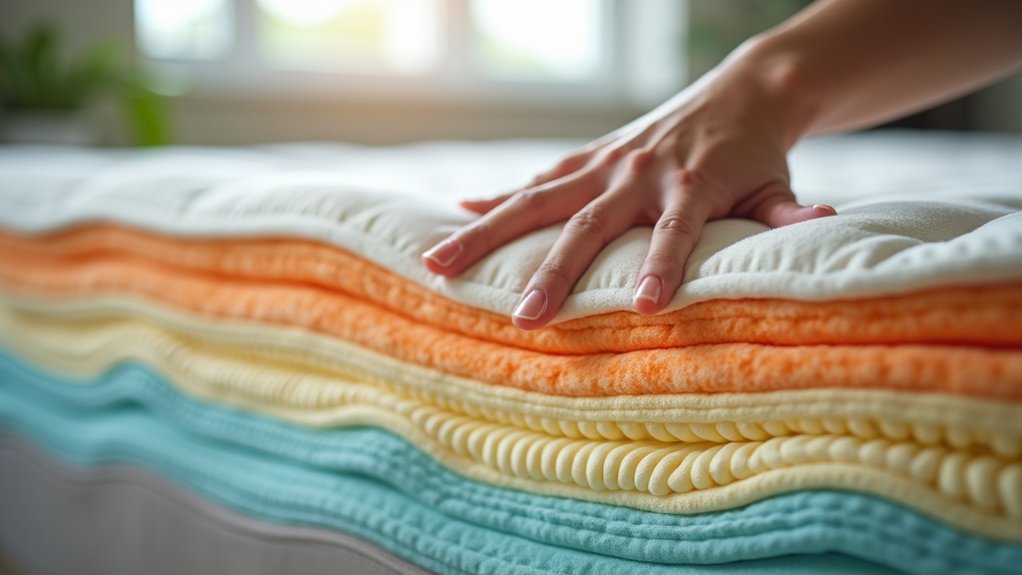
When choosing an innerspring mattress, the coil gauge considerably affects both firmness and overall comfort. Coil gauge refers to the thickness of the wire used in the coils, measured numerically; lower numbers indicate thicker wires.
Impact on Firmness
- Thicker Wires: A lower gauge (12-13) offers a firmer mattress, providing better support for back sleepers and heavier individuals.
- Thinner Wires: A higher gauge (14-17) results in a softer feel, ideal for side sleepers needing pressure relief.
Durability and Support
- Durability: Thicker coils typically maintain their shape longer, ensuring consistent firmness. This is particularly important for mattress longevity as lower gauge coils provide more support over time.
- Weight Support: Lower gauge coils provide enhanced support and reduce motion transfer, making them suitable for various body types.
Sleep Position Considerations
- Back Sleepers: Benefit from firmer mattresses with lower gauge coils.
- Side Sleepers: Prefer softer mattresses; higher gauges are more accommodating.
- Stomach Sleepers: Require firmer options to prevent excessive sinking.
Balanced Choices
A medium gauge (around 13.5 to 14.5) often strikes a balance, offering comfort and support for many sleepers.
Understanding coil gauge helps you select the right mattress for your specific needs.
Mattress Top Options
Selecting the right mattress involves evaluating more than just coil gauge; the type of mattress top can greatly influence your overall sleeping experience. Here are key factors to examine:
Comfort Layers
Modern innerspring mattresses often combine springs with various comfort layers. These layers may include:
- Latex or Memory Foam: Provides support and plushness.
- Breathable Foams: Help regulate temperature, enhancing sleep quality.
- Euro Toppers: Add extra comfort and cooling properties.
Edge Support
Edge support is essential for stability and preventing roll-off. Assess mattresses with:
- Individually Wrapped Coils: Allow for independent compression, enhancing support.
- Reinforced Perimeter Coils: Found in models like the Helix Midnight Luxe, these improve edge strength.
Cover Materials
The mattress cover can affect durability and comfort. Look for:
- Durable Fabrics: Options like 210-denier nylon offer antimicrobial and waterproof benefits.
- Heat-Dissipating Covers: Maintain a cool sleep environment.
Sleep Position and Support
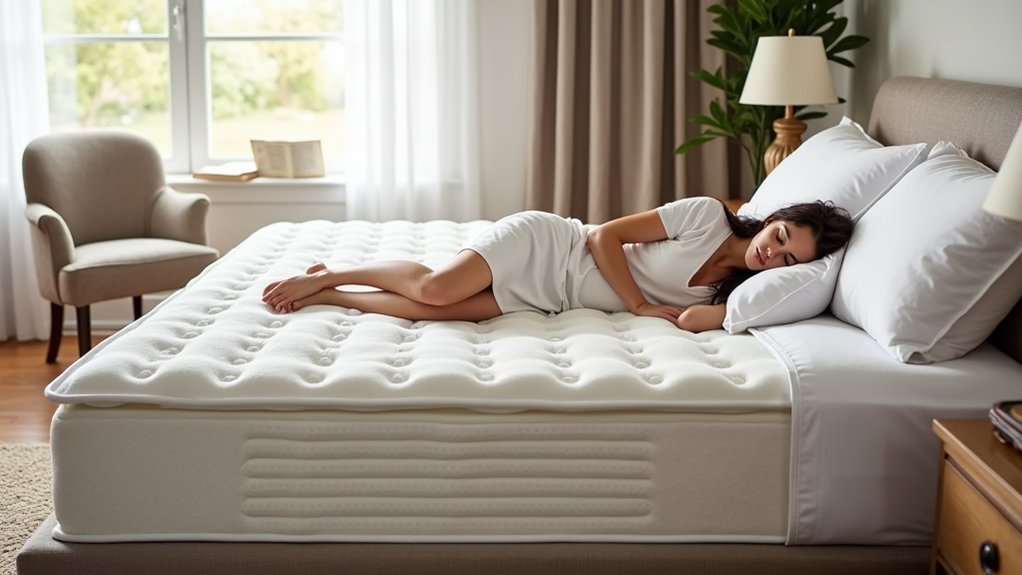
Understanding your sleep position is essential for choosing the right innerspring mattress, as it directly impacts support and comfort. Your sleep position influences the firmness and support levels needed for peak rest.
Side Sleepers
- Comfort Level: You'll benefit from a softer, plush mattress to cushion pressure points at your shoulders and hips.
- Pressure Relief: Pocketed coils provide targeted support, contouring to your body's shape.
Back Sleepers
- Comfort Level: A medium-firm mattress is ideal, supporting the natural curve of your spine.
- Spinal Alignment: Proper lumbar support prevents your hips from sinking excessively, maintaining alignment.
Stomach Sleepers
- Firmness Level: A firmer mattress is necessary to keep your hips aligned with your body, preventing unnatural spinal bowing.
- Support: A robust comfort layer guarantees your body doesn't sink too deeply.
Combination Sleepers
- Flexibility: Innerspring mattresses allow seamless shifts between positions, thanks to responsive coils.
- Motion Isolation: Individually wrapped coils minimize motion transfer, enhancing comfort for you and your partner.
Evaluating Warranty and Trials
Evaluating the warranty and trial options for your innerspring mattress is essential to confirm you make a sound investment. Understanding these components can markedly impact your buying decision.
Warranty Length and Coverage
- Duration: Warranties typically range from 5 to 20 years, with some offering lifetime coverage.
- Coverage Start: Coverage begins on the purchase or delivery date.
- What's Covered: Manufacturing defects, such as broken coils and premature sagging, are usually included.
- Exclusions: Normal wear and tear, fabric issues, and comfort preferences are excluded.
Types of Warranty Coverage
- Repair: Covers fixing damaged components.
- Replacement: Offers a new mattress if yours is irreparable.
- Refund or Store Credit: You may receive a partial or full refund or credit for a new mattress.
- Prorated vs. Non-Prorated: Understand the difference, as coverage may decrease over time as part of a prorated warranty.
Trial Periods
- Duration: Trial periods can last between 30 to 365 nights.
- Purpose: Test the mattress in your home before committing.
- Refund Options: Full refunds or exchanges are available within the trial period.
Review these factors carefully to confirm your mattress meets your needs and expectations.
Price Ranges and Value
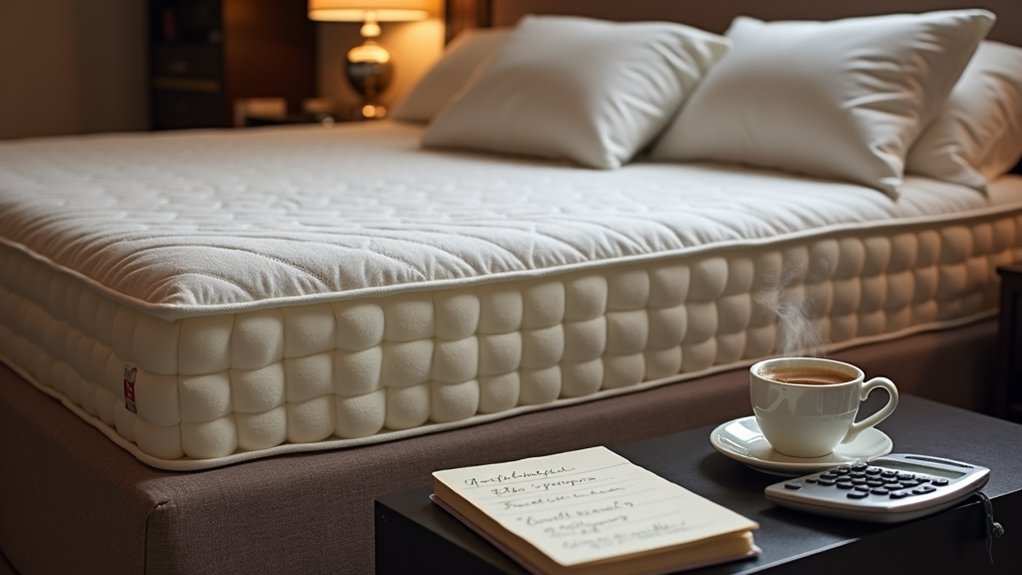
When it comes to purchasing an innerspring mattress, you'll find a wide range of prices that reflect various factors. Understanding these factors is critical for making an informed decision.
Materials and Construction
- Higher quality materials, like organic fibers, considerably increase costs.
- Individually wrapped coils enhance comfort but raise prices.
- Rising steel prices and foam supply issues have impacted overall costs. Delivery dates contingent on available inventory may also affect the overall price you pay.
Mattress Size and Type
- Larger sizes, such as king and queen, typically cost more than twin or full.
- Hybrid models combining innerspring and foam are pricier than all-foam options.
- Pocket spring mattresses offer durability but come at a higher price.
Brand and Quality
- Premium brands often command higher prices due to craftsmanship and materials.
- Models with advanced features, like Euro pillow tops, increase costs.
- Certifications and country of manufacture also influence pricing.
Sales and Discounts
- Seasonal sales and clearance events can considerably lower prices.
- Online sales often provide better deals than traditional retail.
- Price comparisons and bundled deals can enhance value.
Eco-Friendly Mattress Choices
- Organic Cotton: Breathable and free from harmful pesticides, often GOTS certified.
- Natural Latex: Should contain at least 95% organic content to meet GOLS certification, minimizing VOC emissions.
- Organic Wool: Hypoallergenic and anti-microbial, typically sourced from New Zealand.
- Recycled Steel Coils: Provide durability with a reduced environmental impact.
- Plant-Based Foams: Derived from materials like soy or corn, decreasing petroleum reliance. Organic materials contribute to sustainable practices by reducing chemical runoff and pollution from production.
Certifications and Standards
- GOTS: Guarantees at least 70% organic materials, with strict guidelines on chemical treatments.
- GOLS: Requires 95% organic latex, limiting VOC emissions.
- GREENGUARD: Focuses on low VOC emissions, vital for indoor air quality.
Brand Practices
- Avocado: Certified B Corporation, with a fully controlled supply chain.
- Birch: Plants a tree for every mattress sold and holds multiple sustainability certifications.
Choosing eco-friendly options contributes to a healthier planet and promotes better indoor air quality.
